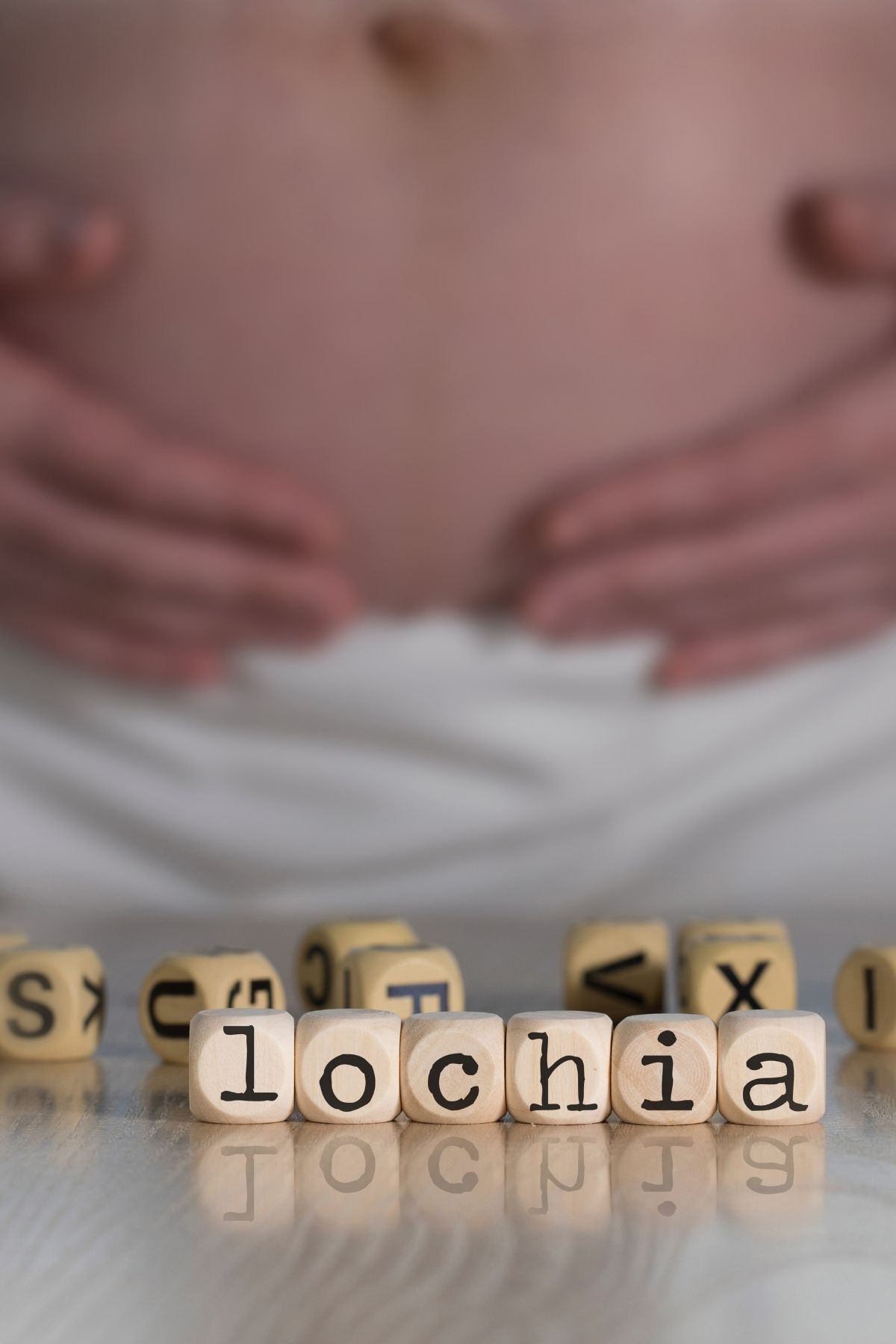Bleeding After Childbirth Stopped Started Again
This post may contain affiliate links. Please visit my disclosure policy for more information.
Within: Should you worry if your postpartum haemorrhage stopped then started again? Here'due south everything you need to know, plus other helpful postpartum tips.
Every outset time mom wants to learn equally much as they tin about labor and commitment, but the postpartum timeline is merely equally important to sympathise.
That'southward peculiarly true for postpartum haemorrhage.
Information technology's normal and natural to experience vaginal haemorrhage after birth, simply it can also be unsafe in certain circumstances.
So, here'due south everything you demand to know about postpartum bleeding, including what to do if your postpartum bleeding stopped and so started once again.
- What is postpartum haemorrhage?
- What To Do If Postpartum Bleeding Stopped Then Started Again
- When To See a Medico
- FAQs
- Want More?
- Your Turn
What is postpartum bleeding?

After delivery, every new mom volition experience postpartum bleeding and vaginal discharge called lochia. This is truthful for those with a vaginal commitment and for women who gave nascence via cesarean department.
Nonetheless, women who experienced a vaginal birth may have heavier and longer postpartum bleeding.
In that location are several factors that tin cause bleeding after birth. Some are normal and beneficial and others may indicate a serious health problem that needs to exist addressed.
- One normal and natural cause of postpartum haemorrhage is the torso ridding itself of the actress tissue, claret, and fungus necessary for pregnancy.
- Bleeding also happens when the placenta separates from the uterus. This separation leaves open claret vessels at the site of detachment that leech out blood. During postpartum, uterine contractions go on in guild to shut off those open vessels.
- However, it is also possible to accept postpartum hemorrhaging, a dangerous condition where backlog bleeding tin can become life-threatening.
Hemorrhaging tin exist caused past uterine rupture (the uterus tears during labor), tears in the vagina or neck during delivery, or uterine atony. Uterine atony is the most common cause of postpartum hemorrhage. This is when the uterus fails to contract after birth to close off those exposed claret vessels.
Luckily, postpartum hemorrhaging (PPH) is rare (only 1-v% of women experience excessive postpartum haemorrhage), merely it's definitely something to keep an eye on after birth.
How long does postpartum bleeding last?
Postpartum haemorrhage tin can last upwardly to 6 weeks, but the heaviest catamenia is typically inside the first three-10 days. If the haemorrhage doesn't terminate effectually the time of your postpartum follow-up date, be sure to allow your medico know.
The color of lochia tends to change with time and tin can bespeak where yous are in your postpartum recovery.
Here are the stages of postpartum bleeding divided past colour:
- Stage one is Lochia rubra. This blood is dark ruddy, similar to a very heavy period, and typically lasts about 4 days. You may feel cramping and even pass some blood clots. This is normal and nothing to worry almost, as long as the clots are smaller than an egg.
- Then, there'south Lochia serosa. Blood volition exist a pinkish shade and your flow will probable be lighter. This lasts about ii weeks.
- The last phase is Lochia alba. Your discharge will be a yellowish or brown color with a little flake of claret. This stage expels those white blood cells responsible for repairing the uterus.
How To Deal With Postpartum Haemorrhage
In add-on to postpartum bleeding, there are several postpartum body changes new mothers have to suffer. Thankfully, most are temporary.
And while lochia lasts longer than most women would prefer, at that place are plenty of products to help bargain with the discomfort.
First, you'll want to accept lots of maternity pads or germ-free pads on paw. You can often stock up on these from the pads provided to you by the hospital. Be sure to snag some of the mesh panties from the hospital, likewise.
Here are some other postpartum essentials your hospital may provide:
- Tucks Pads
- Ice packs
- Peri canteen
- Dermoplast spray
- Inflatable donut cushion
- Stool softeners
If your hospital doesn't provide these items, make sure you purchase them before yous get into labor so you accept them right after nascence and waiting at dwelling.
Call back to avoid soaking in a bathroom or using tampons until subsequently your vi-calendar week engagement. These activities increase the run a risk of infection and tin be detrimental to your health.
What To Do If Postpartum Bleeding Stopped Then Started Again

Information technology's not unusual for postpartum bleeding to change with activity level, to stop and start again or to be characterized by intermittent spotting or bleeding. The lining of the uterus is in the process of healing, and sometimes that healing does non occur at the same fourth dimension throughout the entire lining.
You may experience haemorrhage from the placenta site scab coming off the uterine wall, for example. This may occur a week or two afterward your bleeding seems to have stopped, and may manifest as a sudden gush of bright blood-red claret. This bleeding should taper down within a few days.
Other causes for quantum bleeding are changing levels of hormones and increased physical activeness. Renewed bleeding oft occurs between weeks 5 and 8 postpartum as this is the time new moms start to experience stronger and more similar themselves again and may push themselves too hard.
You lot may also experience a change in blood period in the following circumstances:
- In the morning time correct after waking,
- During physical activity like exercising,
- or while breastfeeding.
Most women won't experience their first period after pregnancy for several months, specially if they're nursing. Withal, not-lactating women typically beginning their normal cycle much sooner.
If you lot're not breastfeeding and feel renewed bleeding around the 2-month mark, it may be your menstruation and not lochia. Keep an center out for changes in basal trunk temperature, changes in cervical mucus, or symptoms you unremarkably experience effectually the time of your menstrual cycle, every bit it may exist the return of Aunt Catamenia.
If haemorrhage stopped and started again under any of the circumstances above and is a light flow, you probable don't need to exercise annihilation dissimilar or have crusade for concern.
When To See a Dr.

If postpartum haemorrhage doesn't finish around the normal time, be sure to allow your doctor know. And if you detect these signs or symptoms, become to the emergency room right abroad or telephone call 911:
- Heavy haemorrhage that'due south bright ruddy beyond the 3rd day afterward nascence
- Claret clots bigger than a plum or egg
- Soaking through more than than i pad in an 60 minutes and it doesn't slow down or stop
- Severe pain
- Changes in vision
- Chills
- Clammy skin
- Rapid heartbeat or elevated blood pressure
- Dizziness
- Weakness or extreme fatigue
- Nausea
- Feeling faint
These symptoms can bespeak a serious medical condition like postpartum hemorrhage or astringent infection.
FAQs
Is bright red claret 3 weeks postpartum normal?
Bright red blood and heavy haemorrhage should taper off around 24-hour interval 3 or 4, postpartum.
If y'all're withal experiencing bright ruddy blood afterward this timeframe, attain out to your doctor right away to rule out postpartum hemorrhage.
How mutual is belatedly postpartum hemorrhage?
Postpartum hemorrhage (PPH) usually occurs inside the kickoff 24 hours after birth but can happen equally far out equally 12 weeks, postpartum. Merely 1-5% of women will experience PPH and late postpartum hemorrhage is extremely rare.
Is it my period or lochia?
Information technology may be hard to tell the divergence betwixt a menses and lochia, but there are some signs to await out for.
If you feel a change in basal body temperature, changes in cervical mucous, or symptoms you normally have before your menstrual wheel, it may be your period. Renewed bright red bleeding after 6 weeks postpartum might exist your menses, especially if you're non breastfeeding.
Want More?
If this information was helpful, be sure to bank check out:
- Postpartum Body Changes You Need to Know
- What Postpartum Depression Feels Like
- The Best Breastfeeding Tips
- 3 First Time Mom Books Worth a Read
- The Ultimate List of Mom Hacks
Your Turn
Nosotros've covered what postpartum bleeding is, what'southward going on if postpartum bleeding stopped and started again and when to be concerned. Did I miss any of your questions? Let me know in the comments!

Source: https://www.loveloveloveblog.com/postpartum-bleeding-stopped-then-started-again/
0 Response to "Bleeding After Childbirth Stopped Started Again"
Post a Comment